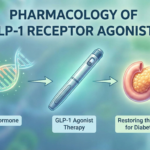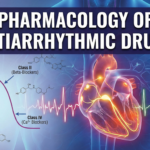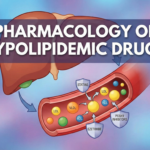Propafenone is a Class 1C antiarrhythmic that produces potent, use‑dependent blockade of fast cardiac Na+ channels with slow unbinding kinetics, resulting in marked conduction slowing and QRS widening, and it also exhibits weak β‑blocking properties that influence rate and bronchial tone in some patients. The following chapter summarizes pharmacology, clinical use, cautions, and monitoring of propafenone drawing primarily from Goodman & Gilman’s and Katzung’s pharmacology textbooks.
Overview
Propafenone is a membrane‑stabilizing agent in Vaughan Williams Class 1C, characterized by strong depression of phase‑0 upstroke in fast‑response tissues and minimal effect on repolarization at therapeutic concentrations. Compared with Class 1A/1B agents, it binds more avidly to open Na+ channels and dissociates slowly, producing pronounced conduction slowing, especially at faster heart rates due to use dependence.
Mechanism of action
- Primary action is potent blockade of fast inward Na+ current, reducing phase‑0 upstroke velocity, slowing intra‑atrial, AV, His‑Purkinje, and ventricular conduction, and widening the QRS complex on ECG.
- Use‑dependent block is prominent, so effects intensify at higher rates and in rapidly activating tissues, which is central to its anti‑reentrant efficacy and to rate‑related QRS widening on exertion or tachycardia.
- Ancillary actions include weak β‑adrenergic antagonism and local anesthetic activity, which can contribute modestly to rate control, negative inotropy, and risk of bronchospasm in susceptible patients.
Electrophysiologic effects
- Atria and AV node: prolongs conduction time and increases refractoriness primarily through Na+ channel effects in atrial tissue, reducing reentry and suppressing premature atrial beats that initiate paroxysmal AF.
- His‑Purkinje and ventricles: markedly slows conduction with minimal action‑potential duration effect at therapeutic levels, producing QRS widening and increased refractoriness in fast‑response myocardium.
- ECG hallmarks: PR prolongation may occur from AV nodal conduction slowing, but the most characteristic change is QRS widening, which correlates with Na+ channel block and requires monitoring during titration.
Pharmacokinetics
- Absorption is high after oral dosing, but a substantial first‑pass effect leads to variable bioavailability, with extended‑release formulations improving pharmacokinetic stability for rhythm maintenance.
- Extensive hepatic metabolism shows notable interindividual variability driven by pharmacogenetic differences, with poor metabolizers exhibiting higher plasma levels, longer half‑life, and greater β‑blocking manifestations.
- Elimination half‑life ranges from roughly 2–10 hours in extensive metabolizers and can be markedly longer in poor metabolizers; hepatic impairment increases exposure, warranting conservative dosing and close ECG monitoring.
Therapeutic indications
- Paroxysmal atrial fibrillation/flutter: prevention of recurrence and suppression of symptomatic paroxysmal episodes in patients without significant structural heart disease is a core indication in many pharmacology texts.
- Paroxysmal supraventricular tachycardia: useful for AV reentry and atrial reentry substrates by slowing atrial/His‑Purkinje conduction and suppressing premature triggers.
- Ventricular arrhythmias: indicated for sustained ventricular tachycardia in selected patients when benefits outweigh risks, typically avoiding use in ischemic or structurally abnormal ventricles due to proarrhythmic concerns.
Dosing and formulations
- Available in immediate‑release and extended‑release oral formulations, with titration guided by clinical response and ECG parameters, particularly QRS duration and PR interval.
- Dose adjustments are prudent in hepatic impairment and in poor metabolizers, with slower titration and enhanced surveillance for conduction slowing, bradyarrhythmias, and negative inotropy.
Contraindications and cautions
- Structural heart disease: Class 1C agents are generally avoided in patients with prior myocardial infarction, ischemic scar, or significant LV dysfunction because conduction slowing can facilitate reentry and proarrhythmia in diseased myocardium.
- Conduction disease: preexisting second/third‑degree AV block, bundle‑branch blocks with QRS prolongation, or sick sinus syndrome are relative or absolute contraindications unless a pacemaker protects against bradyarrhythmia.
- Heart failure and bronchospasm: negative inotropy and weak β‑blockade can worsen decompensated HF and provoke bronchospasm in reactive airway disease, mandating caution or alternative therapy.
Adverse effects
- Cardiovascular: new or worsened ventricular arrhythmias, excessive QRS widening, PR prolongation, AV block, bradycardia, and HF exacerbation represent key dose‑related risks requiring ECG‑guided titration.
- Noncardiac: dizziness, fatigue, metallic taste, gastrointestinal upset, and rarely hematologic or immunologic reactions have been described in standard pharmacology texts.
Drug interactions
- Metabolism: inhibitors or competitors of hepatic pathways that clear propafenone can raise levels and exaggerate Na+ channel block and β‑antagonism, warranting careful review of concomitant therapy in clinical practice.
- Additive electrophysiology: coadministration with other AV‑nodal depressants or Na+ channel blockers can compound bradycardia, AV block, or QRS widening, necessitating conservative dosing and ECG monitoring.
Monitoring
- Baseline and on‑therapy ECG surveillance for PR and especially QRS duration is essential, with dose reduction or discontinuation if excessive widening or conduction block develops.
- Clinical monitoring should track symptoms of dizziness, dyspnea, exercise intolerance, bronchospasm, or HF, alongside periodic reassessment of the arrhythmic indication and structural substrate.
Clinical pearls
- Strong use‑dependence means QRS can widen more during exercise or tachyarrhythmias than at rest, so exertional ECG assessment can be informative during titration in selected patients.
- Compared with flecainide, ancillary β‑blockade with propafenone may modestly assist rate control but also increases risk of bradycardia and bronchospasm, underscoring individualized selection between Class 1C agents.
Comparison with flecainide
Summary
Propafenone is an effective Class 1C agent for suppression of supraventricular arrhythmias and selected ventricular tachycardias in structurally normal hearts, acting via potent, use‑dependent Na+ channel blockade with characteristic conduction slowing and QRS widening. Safe use requires careful patient selection, interaction review, and ECG‑guided dosing to mitigate bradyarrhythmia and proarrhythmia risks, particularly in the presence of structural disease or conduction abnormalities.
References (Vancouver style)
- Brunton LL, Hilal‑Dandan R, Knollmann BC, editors. Goodman & Gilman’s The Pharmacological Basis of Therapeutics. 13th ed. New York: McGraw‑Hill; 2018.
- Hume JR, Grant AO. Agents Used in Cardiac Arrhythmias. In: Katzung BG, editor. Basic & Clinical Pharmacology. 13th ed. New York: McGraw‑Hill; 2015.
📚 AI Pharma Quiz Generator
🎉 Quiz Results
Medical Disclaimer
The medical information on this post is for general educational purposes only and is provided by Pharmacology Mentor. While we strive to keep content current and accurate, Pharmacology Mentor makes no representations or warranties, express or implied, regarding the completeness, accuracy, reliability, suitability, or availability of the post, the website, or any information, products, services, or related graphics for any purpose. This content is not a substitute for professional medical advice, diagnosis, or treatment; always seek the advice of your physician or other qualified health provider with any questions you may have regarding a medical condition and never disregard or delay seeking professional advice because of something you have read here. Reliance on any information provided is solely at your own risk.








